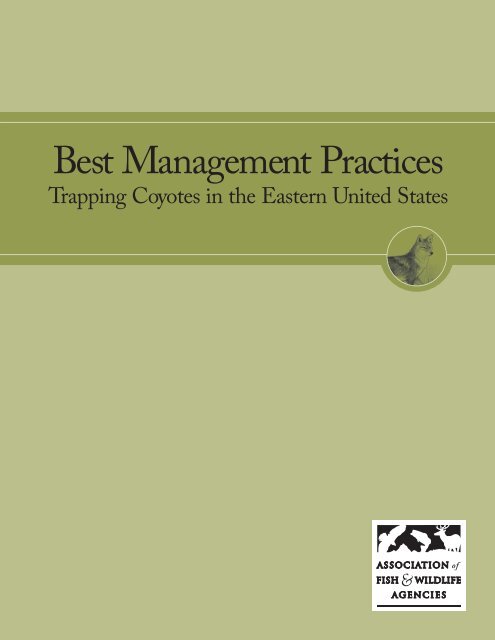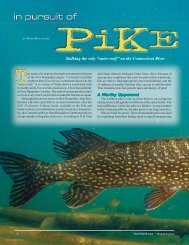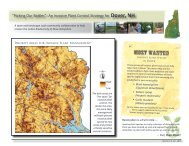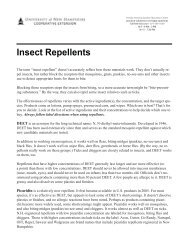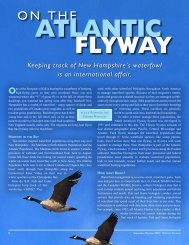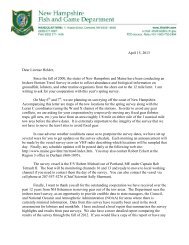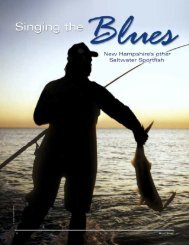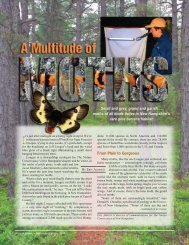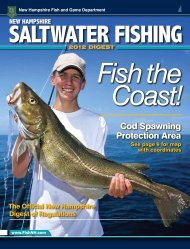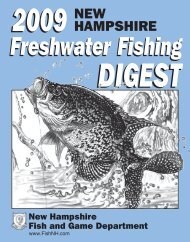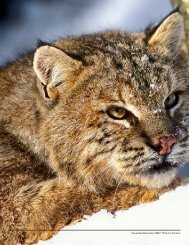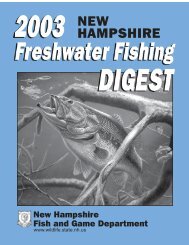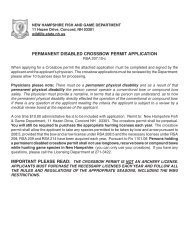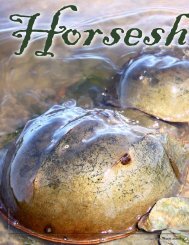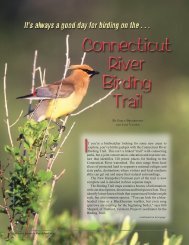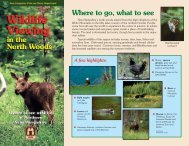Eastern coyote BMPs
Eastern coyote BMPs
Eastern coyote BMPs
You also want an ePaper? Increase the reach of your titles
YUMPU automatically turns print PDFs into web optimized ePapers that Google loves.
Best Management Practices<br />
Trapping Coyotes in the <strong>Eastern</strong> United States
Best Management Practices (<strong>BMPs</strong>) are carefully researched recommendations designed<br />
to address animal welfare and increase trappers’ efficiency and selectivity. The extensive<br />
research and field-testing used to develop <strong>BMPs</strong> are described in the Introduction section<br />
of this manual. The evaluation methods used to develop <strong>BMPs</strong> have been standardized,<br />
enabling <strong>BMPs</strong> to be easily updated and revised as new traps and techniques become<br />
available. All traps listed have been tested and meet performance standards for animal<br />
welfare, efficiency, selectivity, practicality and safety.<br />
Figure EC1. <strong>Eastern</strong> <strong>coyote</strong><br />
(Canis latrans)<br />
Trapping <strong>BMPs</strong> provide options, allowing for discretion and decision making in the<br />
field. They do not present a single choice that can or must be applied in all cases. They<br />
are meant to be implemented in a voluntary and educational approach. <strong>BMPs</strong> are the<br />
product of ongoing work that may be updated as additional traps are identified through<br />
future scientific testing.<br />
The <strong>Eastern</strong> Coyote at a Glance<br />
Characteristics<br />
The <strong>Eastern</strong> <strong>coyote</strong> is a medium to large member of the canid family (Figure EC1).<br />
<strong>Eastern</strong> <strong>coyote</strong>s are somewhat heavier than their Western relatives, and adults average<br />
30-38 pounds. Individuals weighing as much as 60 pounds have been recorded in<br />
some Northeastern states. Adult males are generally larger than adult females. The<br />
scientific name is Canis latrans.<br />
Range<br />
Coyotes occur throughout North America from the edge of the Northern tundra to Central<br />
America. In the United States, all 48 contiguous states and Alaska have populations, though<br />
densities vary with habitat quality. Densities are highest in the Plains region and in the Southcentral<br />
states.<br />
Habitat<br />
Originally an inhabitant of the open grasslands and prairies of the western United States<br />
and southern Canada, the <strong>coyote</strong> has adapted to a wide range of habitat conditions from<br />
Southern swamps to Northern spruce-fir forests. They also occur in urban and suburban<br />
environments, including some of the largest cities in the United States.<br />
Food Habits<br />
Coyotes are opportunistic predators. They commonly prey upon small animals (mice,<br />
rabbits, reptiles and insects), and occasionally pets. They often consume scavenged<br />
food items and carrion, as well as fruits, seeds, and other plant material. Coyotes can<br />
also kill large mammals, such as white-tailed deer and livestock.<br />
Reproduction<br />
Breeding takes place during late January or February in the north and later in the South.<br />
Litters, which average three to six pups, are born about 60 days after breeding. Females<br />
normally do not breed until their second winter. Pairs may remain together for several<br />
years, and both parents care for pups. Young usually disperse from the home territory<br />
in the fall when they are about six months old.<br />
EASTERN COYOTE<br />
2<br />
Association of Fish and Wildlife Agencies
Populations<br />
Although <strong>coyote</strong> populations vary across the East, they are generally considered abundant<br />
as they increase in numbers and become less wary of people. Coyote densities<br />
are highly variable depending on habitat quality and range from one animal for every<br />
seven or eight square miles to an average of more than one animal per square mile.<br />
Adult <strong>coyote</strong>s may range over an area of 2-20 square miles, depending on the time of<br />
year. Family groups defend well-defined territories; pairs and solitary individuals do not.<br />
Comments<br />
Coyote range has expanded dramatically since the mid-1800s. Coyote populations<br />
spread from Western grasslands north to Alaska, west across the Rocky Mountains<br />
to the Pacific Ocean, and east to the Atlantic Coast. This increase in population and<br />
range occurred during a time of extensive habitat change and reduction in wolf<br />
numbers. Few mammals have shown such adaptability. As <strong>coyote</strong>s have occupied<br />
suburban areas they have become less wary of people, and in recent years, attacks<br />
on people have been documented.<br />
General Overview of Traps Meeting BMP<br />
Criteria for Coyotes in the <strong>Eastern</strong> United States<br />
Two basic types of traps were tested for <strong>coyote</strong>s: foothold restraining traps and cable<br />
devices (Table EC2). Examples, brief descriptions, and mechanical details of the various<br />
makes and models that meet BMP criteria are given in the next section.<br />
Table EC2. Overview of traps meeting BMP criteria for <strong>coyote</strong>s in the eastern United States<br />
Trap Category Jaw/Frame Inside Jaw/Frame Inside Width at Jaw/Frame<br />
Characteristics Spread at Dog* Hinge Posts*<br />
Coil-spring Padded 4 1 / 2 - 5<br />
3/ 16 4<br />
9/ 16 - 6<br />
7/ 16<br />
Unmodified 5 - 5 1 / 4 5<br />
Offset, laminated 5 1 / 16 -5 1/ 2 4<br />
3/ 4 - 6<br />
3/ 8<br />
and/or wide<br />
Powered Cable Smooth, round 6 3 / 8 6<br />
Device<br />
rod, 1 / 8 inch cable<br />
Cable Characteristics Loop Diameter Locks<br />
Non-Powered 48 - 60 inches 10 - 12 inches Relaxing locks<br />
Cable Devices<br />
3/ 32 or<br />
1/ 8 inch diameter<br />
stranded cable<br />
* Inches<br />
Best Management Practices for Trapping in the United States<br />
3 EASTERN COYOTE
Inside width<br />
at jaw hinge<br />
posts<br />
Figure EC3. Coil-spring trap<br />
Inside jaw spread<br />
General Considerations When Trapping <strong>Eastern</strong> Coyotes<br />
Jaw-Type Traps<br />
• Many currently used trap models meet specifications<br />
• Pan tension set to four pounds improves selectivity and foot placement in the trap<br />
• Captures and holds animals alive, allowing for release<br />
Powered Cable Devices (Foot Capture)<br />
• Pan tension set to four pounds improves selectivity<br />
• Can be used to capture several furbearer species<br />
• Large cable-loop diameter minimizes capture of smaller species<br />
• Cables require frequent replacement<br />
• Captures and holds animals alive, allowing for release<br />
Non-Powered Cable Devices<br />
• The use of loop stops and breakaway devices can improve selectivity<br />
• Cables require frequent replacement<br />
• Captures and holds animals alive, allowing for release<br />
Specifications of Traps Meeting BMP Criteria<br />
for Coyotes in the <strong>Eastern</strong> United States<br />
As more capture devices are tested and new information becomes available, they will be<br />
added to an updated list. Mechanical descriptions of tested traps are given as an aid to<br />
trappers or manufacturers who may wish to measure, build, or modify traps to meet these<br />
specifications (Figure EC3). Also, other commercially available traps, modified traps, or other<br />
capture devices not yet tested may perform as well as, or better than the listed BMP traps.<br />
References to trap names are provided to identify the specific traps tested. This list is provided<br />
for information purposes only and does not imply an endorsement of any manufacturer.<br />
These are average mechanical measurements which are rounded to the nearest 1 / 16 inch.<br />
There may be up to a 1 / 8 inch variation in specifications on the part of the manufacturer.<br />
Manufacturers use recognizable names, such as “No. 2” coil-spring, to identify certain<br />
traps. However, there is no standardized system linking mechanical design features with<br />
trap names. The mechanical features of these traps are listed so that similar traps may<br />
be identified. The performance of anchoring systems was not specifically evaluated.<br />
However, methods of attachment are described for informational purposes.<br />
EASTERN COYOTE<br />
4<br />
Association of Fish and Wildlife Agencies
Padded Jaws (Figures EC4a and EC4b)<br />
Average Mechanical Description and Attributes<br />
Inside jaw spread (at dog): 4 1 / 2 inches<br />
Inner width: 4 7 / 8 inches<br />
Inside width at jaw hinge posts: 4 9 / 16 inches<br />
Jaw width: 9 / 16 inch round padded jaw<br />
Jaw thickness: 3 / 8 inch<br />
Padding: Manufacturer-supplied rubber pads<br />
Main trap springs: Two 0.131 inch wire-diameter springs<br />
Additional springs: Two 0.100 inch wire-diameter springs<br />
Base plate: Reinforced with D-ring<br />
Any trap that has similar specifications may be considered a BMP trap regardless of<br />
brand or source of modification, although performance information on all other BMP<br />
criteria (see Introduction: “Criteria for Evaluation of Trapping Devices” pages 4-6)<br />
needs to be considered as well. The trap tested was the Woodstream Victor No. 1 1 / 2<br />
Softcatch modified coil-spring, four-coiled.<br />
Additional Information<br />
• Chain attachment used in the trap testing: 7 1 / 2 inch center-mounted with two swivels,<br />
one shock spring, and anchored with a stake.<br />
• Selectivity features: Brass pan tension machine screw; pan tension set so four pounds of<br />
pressure triggered the trap and checked and readjusted as needed after every capture.<br />
• Special considerations for practicality: Some damage to trap pads should be expected<br />
and will require occasional replacement as a normal part of trap maintenance and<br />
upkeep. Special care should be taken to prevent odor contamination of the rubber<br />
jaws. Avoid using petroleum-based dye directly on the rubber pads. This device also<br />
meets BMP criteria for red foxes.<br />
Add’l<br />
springs<br />
Main springs<br />
Padded jaws<br />
Figure EC4a. Padded jaw<br />
coil-spring trap (open)<br />
Padding<br />
Pan tension<br />
screw<br />
Figure EC4b. Padded jaw<br />
coil-spring trap (closed)<br />
Average Mechanical Description and Attributes<br />
Inside jaw spread (at dog): 5 3 / 16 inches<br />
Inner width: 6 1 / 16 inches<br />
Inside width at jaw hinge posts: 6 7 / 16 inches<br />
Jaw width: 9 / 16 inch round padded jaw<br />
Jaw thickness: 3 / 8 inch<br />
Padding: Manufacturer-supplied rubber pads<br />
Main trap springs: Two 0.145 inch wire-diameter springs<br />
Additional springs: Two 0.115 inch wire-diameter springs<br />
Base plate: Reinforced with D-ring<br />
Any trap that has similar specifications may be considered a BMP trap regardless of<br />
brand or source of modification, although performance information on all other BMP<br />
criteria (see Introduction: “Criteria for Evaluation of Trapping Devices” pages 4-6)<br />
needs to be considered as well. The trap tested was the Woodstream Victor No. 3<br />
Softcatch modified coil-spring, four-coiled.<br />
Best Management Practices for Trapping in the United States<br />
5 EASTERN COYOTE
Figure EC5a. Unmodified jaw<br />
coil-spring trap (open)<br />
Additional Information<br />
• Chain attachment used in trap testing: 18 inch center-mounted with three swivels,<br />
two shock springs, and anchored with a stake.<br />
• Selectivity features: Brass pan tension machine screw; pan tension set so four pounds<br />
of pressure triggered the trap and checked and readjusted as needed after every<br />
capture.<br />
• Special considerations for practicality: Some damage to trap pads should be expected<br />
and will require occasional replacement as a normal part of trap maintenance and<br />
upkeep. Special care should be taken to prevent odor contamination of the rubber<br />
jaws. Avoid using petroleum-based dye directly on the rubber pads. This device also<br />
meets BMP criteria for Western <strong>coyote</strong>s.<br />
Figure EC5b. Unmodified jaw<br />
coil-spring trap (closed)<br />
Unmodified Jaws (Figures EC5a and EC5b)<br />
Average Mechanical Description and Attributes<br />
Inside jaw spread (at dog): 5 1 / 4 inches<br />
Inner width: 4 9 / 16 inches<br />
Inside width at jaw hinge posts: 5 inches<br />
Jaw width: 1 / 2 inch smooth round jaw<br />
Jaw thickness: 1 / 8 inch<br />
Main trap springs: Two 0.145 inch wire-diameter springs<br />
Base plate: Not reinforced<br />
Any trap that has similar specifications may be considered a BMP trap regardless of brand<br />
or source of modification, although performance information on all other BMP criteria (see<br />
Introduction: “Criteria for Evaluation of Trapping Devices” pages 4-6) needs to be considered<br />
as well. The trap tested was the Woodstream Victor No. 1.75 coil-spring.<br />
Additional Information<br />
• Chain attachment used in trap testing: 9 1/ 2 inch center-mounted with two swivels,<br />
one shock spring, and anchored with a stake.<br />
• Selectivity features: Brass pan tension machine screw; pan tension set so four pounds<br />
of pressure triggered the trap and checked and readjusted as needed after every<br />
capture.<br />
• Special considerations for practicality: This device also meets BMP criteria for red<br />
foxes and Western <strong>coyote</strong>s.<br />
Average Mechanical Description and Attributes<br />
Inside jaw spread (at dog): 5 inches<br />
Inner width: 4 1 / 2 inches<br />
Inside width at jaw hinge posts: 5 inches<br />
Jaw width: 1 / 2 inch smooth round jaw<br />
Jaw thickness: 1 / 8 inch<br />
Main trap springs: Two 0.145 inch wire-diameter springs<br />
Base plate: Not reinforced<br />
EASTERN COYOTE<br />
6<br />
Association of Fish and Wildlife Agencies
Any trap that has similar specifications may be considered a BMP trap regardless of brand<br />
or source of modification, although performance information on all other BMP criteria (see<br />
Introduction: “Criteria for Evaluation of Trapping Devices” pages 4-6) needs to be considered<br />
as well. The trap tested was the Woodstream Victor No. 2 coil-spring.<br />
Additional Information:<br />
• Chain attachment used in trap testing: 6 inch center-mounted with two swivels and<br />
anchored with a stake.<br />
• Selectivity features: Brass pan tension machine screw; pan tension set so four pounds of<br />
pressure triggered the trap, and checked and readjusted as needed after every capture.<br />
Figure EC6a. Wide jaw, offset trap<br />
Offset, Laminated and/or Wide Jaws<br />
(Figures EC6a, EC6b, EC6c, EC6d and EC6e)<br />
Average Mechanical Description and Attributes<br />
Inside jaw spread (at dog): 5 1 / 16 inches<br />
Inner width: 4 5 / 16 inches<br />
Inside width at jaw hinge posts: 4 3 / 4 inches<br />
Jaw width: 3 / 8 inch smooth oval jaw<br />
Jaw thickness: 1 / 4 inch<br />
Jaw offset: 3/ 16 inch<br />
Main trap springs: Two 0.145 inch wire-diameter springs<br />
Base plate: Not reinforced<br />
Figure EC6b. Laminated, offset trap<br />
(closed)<br />
Any trap that has similar specifications may be considered a BMP trap regardless of<br />
brand or source of modification, although performance information on all other BMP<br />
criteria (see Introduction: “Criteria for Evaluation of Trapping Devices” pages 4-6)<br />
needs to be considered as well. The trap tested was the Sleepy Creek No. 1 3/ 4 coilspring,<br />
wide jaw, offset.<br />
Figure EC6c. Laminated, offset trap<br />
(open)<br />
Additional Information<br />
• Chain attachment on traps tested: 9 1/ 2 inch center-mounted with two swivels,<br />
one shock spring, and anchored with a stake.<br />
• Selectivity features: Brass pan tension machine screw; pan tension set so four<br />
pounds of pressure triggered the trap and checked and readjusted as needed<br />
after every capture.<br />
• Special considerations for practicality: This device also meets BMP criteria for<br />
red foxes.<br />
Best Management Practices for Trapping in the United States<br />
7<br />
EASTERN COYOTE
Average Mechanical Description and Attributes<br />
Inside jaw spread (at dog): 5 1 / 16 inches<br />
Inner width: 4 9 / 16 inches<br />
Inside width at jaw hinge posts: 5 1 / 16 inches<br />
Jaw width: 7 / 16 inch wide, smooth round jaw<br />
Jaw thickness: 5 / 16 inch<br />
Jaw thickness with lamination: 1 / 2 inch<br />
Lamination: 3 / 16 inch above-jaw lamination<br />
Jaw offset: 3 / 16 inch<br />
Main trap springs: Two 0.135 inch wire-diameter springs<br />
Base plate: Not reinforced<br />
Any trap that has similar specifications may be considered a BMP trap regardless of<br />
brand or source of modification, although performance information on all other BMP<br />
criteria (see Introduction: “Criteria for Evaluation of Trapping Devices” pages 4-6) needs<br />
to be considered as well. The trap tested was the Woodstream Victor No.1.75 coilspring<br />
trap modified with offset, laminated jaws.<br />
Additional Information<br />
• Chain attachment used in trap testing: 9 1/ 2 inch center-mounted with two swivels,<br />
one Shock spring, and anchored with a stake.<br />
• Selectivity features: Brass pan tension machine screw; pan tension set so four pounds of<br />
pressure triggered the trap and checked and readjusted as needed after every capture.<br />
• Special considerations for practicality: This device also meets BMP criteria for red<br />
foxes and Western <strong>coyote</strong>s.<br />
Average Mechanical Description and Attributes<br />
Inside jaw spread (at dog): 5 inches<br />
Inner width: 4 11/ 16 inches<br />
Inside width at jaw hinge posts: 5 inches<br />
Jaw width: 3/ 8 inch wide, smooth round jaw<br />
Jaw thickness: 3/ 16 inch<br />
Jaw thickness at flat face: 1 / 4 inch<br />
Jaw offset: 1 / 4 inch<br />
Main trap springs: Two 0.142 inch wire-diameter springs<br />
Base plate: Not reinforced<br />
Any trap that has similar specifications may be considered a BMP trap regardless of<br />
brand or source of modification, although performance information on all other BMP<br />
criteria (see Introduction: “Criteria for Evaluation of Trapping Devices” pages 4-6)<br />
needs to be considered as well. The trap tested was the Oneida-Victor No. 1.75<br />
coil-spring trap, wide jaw, offset.<br />
EASTERN COYOTE<br />
8<br />
Association of Fish and Wildlife Agencies
Additional Information<br />
• Chain attachment used in trap testing: 18 inch center-mounted with three swivels,<br />
one shock spring, and anchored with a stake.<br />
• Selectivity features: Pan tension machine screw; pan tension set so two to four pounds<br />
of pressure triggered the trap and was checked and readjusted as needed after every<br />
capture.<br />
• Special considerations for practicality: This device meets BMP criteria for <strong>Eastern</strong><br />
<strong>coyote</strong>s and Western <strong>coyote</strong>s.<br />
Average Mechanical Description and Attributes<br />
Inside jaw spread (at dog): 5 1 / 4 inches<br />
Inner width: 4 11 / 16 inches<br />
Inside width at jaw hinge posts: 5 1/ 16 inches<br />
Jaw width: 3 / 8 inch wide, smooth round jaw<br />
Jaw thickness: 3 / 16 inch<br />
Jaw thickness at flat face: 1 / 4 inch<br />
Jaw offset: 3 / 16 inch<br />
Main trap springs: Two 0.153 inch wire-diameter springs<br />
Base plate: Not reinforced<br />
Any trap that has similar specifications may be considered a BMP trap regardless of<br />
brand or source of modification, although performance information on all other BMP<br />
criteria (see Introduction: “Criteria for Evaluation of Trapping Devices” pages 4-6)<br />
needs to be considered as well. The trap tested was the Oneida-Victor No. 2 coilspring<br />
trap, wide jaw, offset.<br />
Additional Information<br />
• Chain attachment used in trap testing: 18 inch center-mounted with three swivels,<br />
one shock spring, and anchored with a stake.<br />
• Selectivity features: Pan tension machine screw; pan tension set so two to four pounds<br />
of pressure triggered the trap and was checked and readjusted as needed after every<br />
capture.<br />
• Special considerations for practicality: This device meets BMP criteria for <strong>Eastern</strong><br />
<strong>coyote</strong>s and Western <strong>coyote</strong>s.<br />
Best Management Practices for Trapping in the United States<br />
9<br />
9 EASTERN COYOTE
Figure EC6d. Laminated, offset<br />
dogless trap (open)<br />
Figure EC6e. Laminated, offset<br />
dogless trap (closed)<br />
Average Mechanical Description and Attributes<br />
Inside jaw spread (at dog): 5 1/ 2 inches<br />
Inside jaw spread (between below-jaw lamination): 5 inches<br />
Inner width: 5 1 / 16 inches<br />
Inside width at jaw hinge posts: 5 9 / 16 inches<br />
Jaw width: 7 / 16 inch hexagonal jaw<br />
Jaw thickness: 1 / 16 inch<br />
Jaw thickness with lamination: 7 / 16 inches<br />
Lamination: 1 / 4 inch<br />
Jaw offset: 3 / 16 inch<br />
Main trap springs: Two 0.145 inch wire-diameter springs<br />
Additional springs: Two 0.110 inch wire-diameter springs<br />
Base plate: Reinforced with D-ring<br />
Any trap that has similar specifications may be considered a BMP trap regardless of<br />
brand or source of modification, although performance information on all other BMP<br />
criteria (see Introduction: “Criteria for Evaluation of Trapping Devices” pages 4-6)<br />
needs to be considered as well. The trap tested was the Bridger No.2 coil-spring<br />
modified with offset, laminated jaws, four-coiled.<br />
Additional Information<br />
• Chain attachment used in trap testing: 18 inch center-mounted with three swivels,<br />
two shock springs, and anchored with a stake.<br />
• Selectivity features: Brass pan tension machine screw; pan tension set so four<br />
pounds of pressure triggered the trap and checked and readjusted as needed<br />
after every capture.<br />
• Special considerations for practicality: This device also meets BMP criteria for<br />
Western <strong>coyote</strong>s and red foxes.<br />
Average Mechanical Description and Attributes<br />
Inside jaw spread (at dog): 5 3/ 4 inches<br />
Inner width: 5 1/ 4 inches<br />
Inside width at jaw hinge posts: 6 inches<br />
Jaw width: 1/ 2 inch wide, square jaw<br />
Jaw thickness: 3/ 16 inch<br />
Jaw thickness with lamination: 1/ 2 inch<br />
Lamination: 1 / 4 inch above-jaw lamination<br />
Jaw offset: 3 / 16 inch<br />
Main trap springs: Two 0.150 inch wire-diameter springs<br />
Base plate: Reinforced with D-ring<br />
Any trap that has similar specifications may be considered a BMP trap regardless of<br />
brand or source of modification, although performance information on all other BMP<br />
criteria (see Introduction: “Criteria for Evaluation of Trapping Devices” pages 4-6)<br />
needs to be considered as well. The trap tested was the Montana Special No. 3<br />
dogless coil-spring trap modified with offset, laminated jaws (lamination on top of jaws).<br />
EASTERN COYOTE<br />
10<br />
Association of Fish and Wildlife Agencies
Additional Information<br />
• Chain attachment used in trap testing: 18 inch center-mounted with three swivels,<br />
one shock spring, and anchored with a stake.<br />
• Selectivity features: Pan tension machine screw; pan tension set so two to four<br />
pounds of pressure triggered the trap and was checked and readjusted as needed<br />
after every capture.<br />
• Special considerations for practicality: This device meets BMP criteria for <strong>Eastern</strong><br />
<strong>coyote</strong>s and Western <strong>coyote</strong>s.<br />
Average Mechanical Description and Attributes<br />
Inside jaw spread (at dog): 5 1 / 2 inches<br />
Inside jaw spread (between below-jaw lamination): 5 inches<br />
Inner width: 6 inches<br />
Inside width at jaw hinge posts: 6 3 / 8 inches<br />
Jaw width: 1 / 2 inch hexagonal jaw<br />
Jaw thickness: 3 / 16 inch<br />
Jaw thickness with lamination: 5 / 8 inch<br />
Lamination: 3/ 16 inch above-jaw, 1/ 4 inch below-jaw<br />
Jaw offset: 1/ 4 inch<br />
Main trap springs: Two 0.160 inch wire-diameter springs<br />
Additional springs: Two 0.115 inch wire-diameter springs<br />
Base plate: Reinforced with D-ring<br />
Any trap that has similar specifications may be considered a BMP trap regardless of<br />
brand or source of modification, although performance information on all other BMP<br />
criteria (see Introduction: “Criteria for Evaluation of Trapping Devices” pages 4-6)<br />
needs to be considered as well. The trap tested was the Bridger No. 3 coil-spring,<br />
modified, offset (by manufacturer), double laminated, four-coiled.<br />
Additional Information<br />
• Chain attachment used in trap testing: 18 inch center-mounted with three swivels,<br />
two shock springs, and attached to a metal grapple.<br />
• Selectivity features: Brass pan tension machine screw; pan tension set so four pounds<br />
of pressure triggered the trap and checked and readjusted as needed after every<br />
capture.<br />
• Special considerations for practicality: This device also meets BMP criteria for<br />
Western <strong>coyote</strong>s.<br />
Best Management Practices for Trapping in the United States<br />
11 EASTERN COYOTE
Figure EC7a. Powered cable device<br />
Figure EC7b. Powered cable device (set)<br />
Powered Cable Devices (Foot Capture) (Figures EC7a and EC7b)<br />
Average Mechanical Description and Attributes<br />
Inside cable retention frame spread (at dog): 6 3 / 8 inches<br />
Inner width: 5 3 / 4 inches<br />
Inside width at frame hinge posts: 6 inches<br />
Cable retention frame width: 1 / 8 inch, smooth round rod<br />
Cable retention frame thickness: 1 / 8 inch rod<br />
Main trap springs: Two 0.188 inch wire-diameter rod quick-release springs<br />
Cable diameter: 1 / 8 inch cable<br />
Cable loop stop size: 2 inches<br />
Base plate: Not reinforced<br />
Any cable device that has similar specifications may be considered a BMP device regardless<br />
of brand or source of modification, although performance information on all other BMP<br />
criteria (see Introduction: “Criteria for Evaluation of Trapping Devices” pages 4-6) needs to<br />
be considered as well. The trap tested was the Belisle Foot Snare.<br />
Additional Information<br />
• Cable attachment on device tested: Swivel and lunge spring with a cable anchor.<br />
• Selectivity features: Pan tension machine screw; large cable diameter and available<br />
plastic sleeve work to prevent the cable from closing to a small diameter, thus<br />
allowing small animals such as squirrels, skunks and some raccoons to escape.<br />
• Special considerations for practicality: Some damage and kinking of cable should be<br />
expected and will require frequent replacement as a normal part of trap maintenance<br />
and upkeep. This device also meets BMP criteria for red foxes and Western <strong>coyote</strong>s.<br />
Non-Powered Cable Devices (Figures EC8a and EC8b)<br />
Average Mechanical Description and Attributes<br />
Cable diameter: 3 / 32 inch, 7 x 7 or 7 x 19 stranded cable<br />
Cable length: 48 and 60 inches<br />
Cable loop stop size: 2 1 / 2 inches<br />
Cable lock: Relaxing locks<br />
Catch loop size: 10-12 inches<br />
Stop button: 3 / 32 inch ferrule<br />
EASTERN COYOTE<br />
12<br />
Association of Fish and Wildlife Agencies
Any cable device that has similar specifications may be considered a BMP device<br />
regardless of brand or source of modification, although performance information on<br />
all other BMP criteria (see Introduction: “Criteria for Evaluation of Trapping Devices”<br />
pages 4-6) needs to be considered as well. Relaxing locks used were the Reichart<br />
washer lock, #4 Gregerson lock and the BMI Slide Free lock.<br />
Additional Information<br />
• 3 / 32 inch diameter cable extensions made of 7 x 7 stranded cable of 12, 14, 16,<br />
or 24 inches in length were used for anchoring cable restraint devices, connected<br />
by a #9 swivel.<br />
• The bottom of the cable restraint catch loop should be > 10 inches to < 12 inches<br />
from the surface directly below the set.<br />
• Special considerations for selectivity: Breakaway devices allow escape with sufficient<br />
force; the use of a maximum loop stop prevents larger animals from entering the<br />
restraint, while the minimum loop prevents the restraint from closing around an<br />
animal’s foot. Breakaway amounts may vary based on regional needs where the<br />
potential capture of protected mammals and/or livestock exists.*<br />
• Special considerations for practicality: Some damage and kinking of cable should be<br />
expected and will require frequent replacement as a normal part of maintenance and<br />
upkeep. This device also meets BMP criteria for red foxes.<br />
Figure EC8a. Typical breakaway<br />
Breakaway<br />
S-hook<br />
Figure EC8b. Non-powered cable<br />
device<br />
Average Mechanical Description and Attributes<br />
Cable diameter: 1 / 8 inch, 7 x 7 or 7 x 19 stranded cable<br />
Cable length: 48 and 60 inches<br />
Cable loop stop size: 2 1 / 2 inches<br />
Cable lock: Relaxing locks<br />
Catch loop size: 10-12 inches<br />
Stop button: 1 / 8 inch ferrule<br />
Any cable device that has similar specifications may be considered a BMP device<br />
regardless of brand or source of modification, although performance information on<br />
all other BMP criteria (see Introduction: “Criteria for Evaluation of Trapping Devices”<br />
pages 4-6) needs to be considered as well. Relaxing locks used were the Reichart<br />
washer lock, #4 Gregerson lock, and the BMI Slide Free lock.<br />
Additional Information<br />
• 1/ 8 inch diameter cable extensions made of 7 x 7 stranded cable of 12, 14, 16, or<br />
24 inches in length were used for anchoring cable restraint devices, connected by a<br />
#9 swivel.<br />
• The bottom of the cable restraint catch loop should be > 10 inches to < 12 inches<br />
from the surface directly below the set.<br />
• Special considerations for selectivity: Breakaway devices allow escape with sufficient<br />
force; the use of a maximum loop stop prevents larger animals from entering the<br />
restraint while the minimum loop prevents the restraint from closing around an<br />
animal’s foot. Breakaway amounts may vary based on regional needs where the<br />
potential capture of protected mammals and/or livestock exists.*<br />
• Special considerations for practicality: Some damage and kinking of cable should be<br />
expected and will require frequent replacement as a normal part of maintenance and<br />
upkeep. This device also meets BMP criteria for red foxes.<br />
* Breakaways (“S” hooks, “J” hooks and ferrules) used with manufacturer ratings of 185 pounds and 285 pounds.<br />
Best Management Practices for Trapping in the United States<br />
13 EASTERN COYOTE


